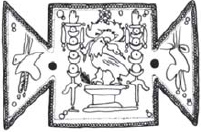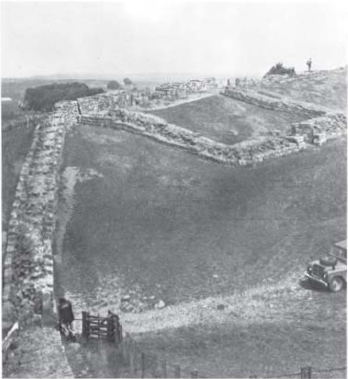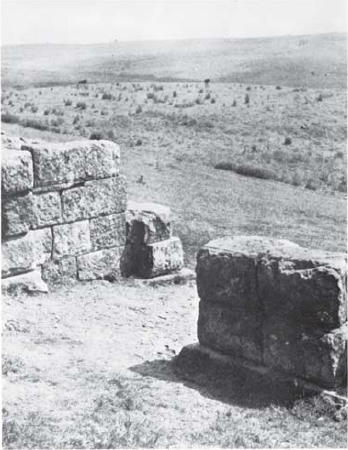

| A.D. 117: | Marcus Ulpius Trajanus dies at the age of sixty-five and is succeeded by his nephew, Publius Aelius Hadrianus. Hadrianus’s reign saw extensive building works, both civil and military, including the construction of the great defence work in northern Britain known as Hadrian’s Wall. |
| A.D. 138: | Hadrianus dies after a stable reign aged sixty-two. Succession passes to Titus Aelius Antoninus, who was adopted by Hadrianus as his heir after the death in 138 of Lucius Aelius Verus Caesar, his primary adoption. Antoninus, known as Antoninus Pius, pursues a policy of consolidation, with the notable exception of the Lowlands of Scotland, where the frontier is advanced to a line between the River Clyde and the Firth of Forth, known as the Antonine Wall. |
| A.D. 161: | Marcus Aurelius, nephew and adopted heir of Antoninus Plus succeeds. His reign heralds the end of a long, happy period in the history of Rome. His armies depleted by an extensive plague, he is obliged to fight against barbarian incursions for most of his years as Emperor. He dies at the age of sixty-nine, having almost reconsolidated the frontiers. |
| A.D. 180: | Lucius Aelius Aurelius Commodus becomes Emperor on the death of his father, Marcus Aurelius. Owing to the profligate nature of his mother, Faustina the Younger, it is possible that Commodus was not Aurelius’s son; he proves to be a dissolute and evil individual. He is finally assassinated by strangulation in 192. |
| A.D. 193: | Publius Helvius Pertinax is made Emperor against his will and is murdered shortly thereafter by the Praetorian Guard. Marcus Didius Salvius Julianus purchases the throne at an auction, but is killed almost immediately. Lucius Septimius Severus emerges as victor from the ensuing civil war and assumes complete control. North British tribes take advantage of the disorder caused by the civil war and severely damage Hadrian’s Wall. Extensive repairs to that defence work are carried out by Severus. |
| A.D. 208: | Britain is divided into two Provinces. |
| A.D. 211: | Severus dies at the age of sixty-five and the succession passes to his two sons: Marcus Aurelius Antoninus, nicknamed Caracalla after his custom of wearing a long Gallic coat, and Lucius Septimius Geta. |
| A.D. 212: | Roman citizenship is granted to all freeborn subjects within the Empire. Caracalla becomes dissatisfied with joint rule and arranges his brother’s murder along with his supporters. Caracalla then becomes sole Emperor; cruel and treacherous, he is killed five years later at the age of twenty-nine by Marcus Opelius Severus Macrinus. |
| A.D. 217: | Macrinus succeeds to the throne and undertakes an unsuccessful campaign against the Parthians. He becomes unpopular with his soldiers and is murdered at the age of fifty-four in 218, after defeat in battle against his successor, Elagabalus. |
| A.D. 218: | Marcus Aurelius Antoninus, known as Elagabalus or Heliogabalus, originally named Varius Avitus Bassianus, served as a priest at Emesa in Syria at the age of fourteen. Upon succession he proves to be a degenerate and is eventually assassinated by the Praetorian Guard at the age of eighteen. |
| A.D. 222: | Elagabalus is succeeded by his cousin Severus Alexander, who rules justly. Unfortunately, he is later murdered by soldiers during a revolt in Germany. |
| A.D. 235: | Caius Julius Verus Maximinus, Maximinus I, is made Emperor by the Rhine legions on the murder of Severus Alexander, but is declared a public enemy by the Senate in 238 and is eventually put to death. |
| A.D. 238: | Marcus Antoninus Gordianus is proclaimed Emperor in Africa and becomes Gordianus Africanus I by the authority of the Senate, but commits suicide a little over a month later, having learned of the death of his son and co-ruler Marcus Antonianus Gordianus, Gordianus Africanus II, at Carthage. Decimus Caelius Balbinus and Marcus Clodius Pupienus Maximus are appointed joint Emperors to destroy Maximinus, who remains a threat. Upon the death of Maximinus, both Balbinus and Pupienus are killed by the Praetorian Guard, who hail Marcus Antonius Gordianus, grandson of Gordianus I, as Emperor Gordianus III Pius. |
| A.D. 244: | Marcus Julius Phillipus, an officer of the Praetorian Guard, plots against Gordianus Plus and the latter is murdered at the age of twenty-one. Phillipus succeeds as Phillipus I. |
| A.D. 249: | The Danube legions revolt against Phillipus and force their commander, Caius Messius Quintus Trajanus Decius, to assume the title of Emperor. Decius engages Phillipus in battle and the latter is killed. |
| A.D. 251: | During a campaign in Thrace to throw back an invasion by the Goths, Decius is killed in battle at Abrittus and is succeeded by Caius Vibius Trebonianus Gallus. |
| A.D. 253: | The legions of Pannonia and Moesia mutiny against Gallus under the Governor Marcus Aemilius Aemilianus, who is named Emperor by his troops. Aemilianus engages the forces of Gallus and defeats them. Gallus is then killed by his own men, despite support from Publius Licinius Valerianus, who was unable to reach Gallus in time to prevent defeat at the hands of Aemilianus. |
| After the death of Gallus, Valerianus and his son Publius Licinius Valerianus Egnatius Gallienus are proclaimed joint Emperors, ruling together until A.D. 260 when, during a border campaign, Valerianus is defeated and captured by the Persian, Shapur I, remaining a prisoner until he dies. The defeat of Valerianus may have been largely due to the actions of Marcus Fulvius Macrianus, who is nevertheless hailed Emperor by the troops. However, on his way back to Italy, he is confronted by one of Valerianus’s generals, brought to battle and killed, together with his son and collaborator. |

The milecastle at Cawfields on Hadrian’s Wall.
| A.D. 259: | Marcus Cassianus Latinus Postumus, the Governor of Gaul, declares himself Emperor and continues to rule in Gaul and Britain until 267 when he is killed in battle. |
| A.D. 265: | Postumus names Marcus Piavvonius Victorinus as his co-ruler. Victorinus continues to rule alone after the death of Postumus until 270, when he is assassinated. |
| A.D. 268: | The reign of Gallienus ends with his murder at the age of fifty and he is succeeded by Marcus Aurelius Claudius II, who stems incursions by the Alamanni, who have penetrated into Italy, and by the Goths in Moesia. |
| A.D. 270: | Claudius II succumbs to plague. Lucius Domitius Aurelianus succeeds against opposition from Caius Marcus Aurelius Claudius Quintillus, who commits suicide once his cause is lost. Aurelianus forces the Goths to retire back across the River Danube, then turns his attention to Palmyra in Syria, defeating and capturing its Queen Zenobia. He is also responsible for the building of great defensive walls at Rome, much of which are visible today. |
| A.D. 275: | Aurelianus falls victim to a conspiracy. Marcus Claudius Tacitus is proclaimed Emperor by the Senate, but is slain by troops a few months later. |
| A.D. 276: | Marcus Annius Florianus, half-brother of Tacitus, holds power for some weeks, but is killed in battle by Marcus Aurelius Probus, a good soldier and administrator, who is later put to death during an army mutiny. |
| A.D. 283: | Marcus Aurelius Carus is elected Emperor by the army, but is killed shortly thereafter while campaigning against the Persians. His two sons, Marcus Aurelius Carinus and Marcus Aurelius Numerianus reign jointly after their father’s death. |

The remains of the south gateway at Cawfields milecastle.
| A.D. 284: | Numerianus dies and Caius Aurelius Valerius Diocletianus is proclaimed Emperor. He carries out many reforms, including an attempt to revive the old state religions, bringing about a severe persecution of the Christian sect. In 286, Diocletianus associates himself with Marcus Aurelius Valerius Maximianus in joint rule and both men finally abdicate in 305. |
| A.D. 287: | Marcus Aurelius Mausaeus Carausius, commander of the Gallic fleet, rebels against Maximianus, takes his marine force to Britain and there declares himself Emperor. |
| A.D. 293: | Carausius is murdered by his chief minister of finance Caius Allectus who usurps his position. At about the same date, Flavius Valerius Constantius lays siege to and takes Boulogne. |
| A.D. 296: | Constantius invades Britain and retakes the Province for Rome. Allectus is killed in the fighting. The fortress of Eboracum (York) and Hadrian’s Wall are rebuilt. |
| A.D. 305: | Diocletianus and Maximianus abdicate and are succeeded by Constantius, Constantius I Chlorus. Caius Galerius Valerius Maximianus, created Caesar by Diocletianus, takes the title Augustus and names Flavius Valerius Severus as Caesar. |
| A.D. 306: | On the death of Constantius Chlorus, Flavius Valerius Aurelius Constantinus is proclaimed Emperor at Eboracum. Marcus Aurelius Valerius Maxentius, son of Maximianus, opposes Galerius and Severus with the aid of the Praetorian Guard. He eliminates Severus and causes Galerius to flee from Italy. |
| A.D. 308: | Constantinus takes the title of Augustus in opposition to Maxentius. |
| A.D. 312: | Constantinus inflicts defeat on Maxentius at the battle of Pons Milvius, and Maxentius perishes in the River Tiber during the ensuing rout. Constantinus shares power with Galerius Valerius Maximinus—Maximinus II Daza—and Publius Flavius Galerius Valerius Licianus—Licinus I. Licinius eliminates Maximinus. |
| A.D. 313: | Constantinus and Licinius issue the Edict of Milan, which recognizes Christianity as the official religion. |
| A.D. 324: | Licinius moves against Constantinus, but fails and is killed. Constantinus becomes sole Emperor. |
| A.D. 331: | Constantinus moves the seat of Imperial Government to the city of Byzantium and renames it Constantinople. |

Readers are advised to consult the author’s previous book in this series, The Roman Army from Caesar to Trajan, for certain basic background information which for reasons of space is not repeated here.